The Effects of Hydroxypropyl Methyl Cellulose and Metakaolin on the Properties of Self-Compacting Solidified Soil Based on Abandoned Slurry
Abstract
1. Introduction
2. Experiment
2.1. Experimental Materials
2.2. Methods
2.2.1. Preparation, Curing, and Mix Design of Specimens
2.2.2. Water Bleeding Rate
2.2.3. Flowability
2.2.4. Unconfined Compressive Strength
2.2.5. Microscopic Analysis
3. Results and Discussion
3.1. The Effect of HPMC on the Bleeding Rate of Self-Compacting Solidified Soil
3.2. The Influence of HPMC and Metakaolin on the Flowability of Self-Compacting Solidified Soil
3.2.1. The Impact of HPMC on the Flowability of Self-Compacting Solidified Soil
3.2.2. The Effect of Metakaolin on the Flowability of Self-Compacting Solidified Soil
3.3. The Effect of HPMC and Metakaolin on the Compressive Strength of Self-Compacting Solidified Soil
3.3.1. The Impact of HPMC on the Compressive Strength of Self-Compacting Solidified Soil
3.3.2. The Effect of Metakaolin on the Compressive Strength of Self-Compacting Solidified Soil
3.4. The Effects of HPMC and Metakaolin on the Phase Composition
3.5. The Effects of HPMC and Metakaolin on the Microstructure
4. Conclusions
- (1)
- Hydroxypropyl methylcellulose (HPMC) effectively reduced the bleeding rate of the soil. At an HPMC content of 0.3%, the bleeding rate was successfully brought down to less than 1%. Additionally, higher molecular weight HPMC exhibited a superior water retention capacity. Simultaneously, HPMC enhanced the fluidity of the soil, with a more significant impact observed with higher molecular weights. Specifically, peak fluidity was achieved when the content of HPMC-10 reached 0.4% and HPMC-20 reached 0.3%. However, beyond these optimal contents, the fluidity began to decline. Conversely, metakaolin had a negative impact on fluidity, with increasing metakaolin content leading to a continuous decrease in fluidity.
- (2)
- HPMC significantly influenced the compressive strength of the solidified soil. Both molecular weights of HPMC maximized the compressive strength at a dosage of 0.3%. Exceeding this dosage resulted in a decrease in strength, with a more pronounced effect for the higher molecular weight variant. Furthermore, HPMC attenuated the strength growth of the soil between 7 and 14 days, while having minimal impact on strength growth from 14 to 28 days. On the other hand, metakaolin effectively boosted the compressive strength of the soil and facilitated strength growth throughout the entire curing period.
- (3)
- Neither HPMC nor metakaolin had a notable effect on the phase composition of the self-compacting solidified soil. However, the water-retaining property of HPMC facilitated more thorough hydration of cement, leading to the observation of increased ettringite in the microstructure. Meanwhile, metakaolin, due to its high surface energy, reacted with calcium hydroxide on the surface of cement and clay particles, resulting in distinct microstructural changes.
Author Contributions
Funding
Institutional Review Board Statement
Informed Consent Statement
Data Availability Statement
Conflicts of Interest
References
- Zhu, H.; Sun, H.; Wang, F.; Zou, J.; Fan, J. Preparation of chitosan-based flocculant for high density waste drilling mud solid–liquid separation. J. Appl. Polym. Sci. 2012, 125, 2646–2651. [Google Scholar] [CrossRef]
- Fang, K.; Zhang, Z.-M.; Liu, J.-C. Pollution of construction waste slurry and prevention measures. Chin. J. Geotech. Eng. 2011, 33, 238–241. [Google Scholar]
- Ryu, Y.-M.; Kwon, Y.-S.; Kim, T.-H.; Lee, I.-M. Slurry Clogging Criteria for Slurry Shield Tunnelling in Highly Permeable Ground. KSCE J. Civ. Eng. 2019, 23, 2784–2793. [Google Scholar] [CrossRef]
- Lang, L.; Chen, B.; Chen, B. Strength evolutions of varying water content-dredged sludge stabilized with alkali-activated ground granulated blast-furnace slag. Constr. Build. Mater. 2021, 275, 122111. [Google Scholar] [CrossRef]
- Dong, C.-Q.; Zhang, R.-J.; Zheng, J.-J.; Jiang, W.-H. Strength behavior of dredged mud slurry treated jointly by cement, metakaolin and flocculant. Appl. Clay Sci. 2020, 193, 105676. [Google Scholar] [CrossRef]
- Lang, L.; Chen, B.; Li, N. Utilization of lime/carbide slag-activated ground granulated blast-furnace slag for dredged sludge stabilization. Mar. Georesour. Geotechnol. 2021, 39, 659–669. [Google Scholar] [CrossRef]
- Lang, L.; Song, C.; Xue, L.; Chen, B. Effectiveness of waste steel slag powder on the strength development and associated micro-mechanisms of cement-stabilized dredged sludge. Constr. Build. Mater. 2020, 240, 117975. [Google Scholar] [CrossRef]
- Kamperidou, V.; Terzopoulou, P.; Barboutis, I. Marginal lands providing tree-crop biomass as feedstock for solid biofuels. Biofuels Bioprod. Biorefining 2021, 15, 1395–1405. [Google Scholar] [CrossRef]
- Bo, M.W.; Choa, V.; Chu, J.; Arulrajah, A.; Horpibulsuk, S. Laboratory investigation on the compressibility of Singapore marine clays. Mar. Georesources Geotechnol. 2017, 35, 847–856. [Google Scholar] [CrossRef]
- Wu, Y.; Lu, Y.; Niu, K.; Sun, D. Experimental study on solid-liquid separation of construction waste slurry by additive agent-combined vacuum preloading. Chin. J. Geotech. Eng. 2016, 38, 1365–1373. [Google Scholar] [CrossRef]
- Chang, I.; Im, J.; Cho, G.-C. Introduction of microbial biopolymers in soil treatment for future environmentally-friendly and sustainable geotechnical engineering. Sustainability 2016, 8, 251. [Google Scholar] [CrossRef]
- Wu, L.; Zhan, L.; Zhang, S.; Song, X.; Lu, J.; Wang, Y. Decision analysis on disposal of large quantities of excavated soft soil in abandoned mines using a Bayesian network. Int. J. Min. Reclam. Environ. 2022, 36, 419–442. [Google Scholar] [CrossRef]
- Huang, T.; Kou, S.; Liu, D.; Li, D.; Xing, F. A BIM-GIS-IoT-Based system for excavated soil recycling. Buildings 2022, 12, 457. [Google Scholar] [CrossRef]
- Guo, Q.; Zhan, L.; Shen, Y.; Wu, L.; Chen, Y. Classification and quantification of excavated soil and construction sludge: A case study in Wenzhou, China. Front. Struct. Civ. Eng. 2022, 16, 202–213. [Google Scholar] [CrossRef]
- Wang, J.-N.; Xu, H.; Zhan, L.-T.; Li, S.-Z.; Wang, L.-N. Stability satisfied design and construction of excavated soil dumps in a soft soil region in China. Front. Earth Sci. 2022, 9, 822511. [Google Scholar] [CrossRef]
- Lafhaj, Z.; Samara, M.; Agostini, F.; Boucard, L.; Skoczylas, F.; Depelsenaire, G. Polluted river sediments from the North region of France: Treatment with Novosol® process and valorization in clay bricks. Constr. Build. Mater. 2008, 22, 755–762. [Google Scholar] [CrossRef]
- Zhang, N.; Zhang, H.; Schiller, G.; Feng, H.; Gao, X.; Li, E.; Li, X. Unraveling the Global Warming Mitigation Potential from Recycling Subway-Related Excavated Soil and Rock in China Via Life Cycle Assessment. Integr. Environ. Assess. Manag. 2021, 17, 639–650. [Google Scholar] [CrossRef] [PubMed]
- Abadel, A.A.; Alghamdi, H.; Alharbi, Y.R.; Alamri, M.; Khawaji, M.; Abdulaziz, M.A.M.; Nehdi, M.L. Investigation of alkali-activated slag-based composite incorporating dehydrated cement powder and red mud. Materials 2023, 16, 1551. [Google Scholar] [CrossRef] [PubMed]
- Wang, Q.; Chu, H.; Shi, W.; Jiang, J.; Wang, F. Feasibility of preparing self-compacting mortar via municipal solid waste incineration bottom ash: An experimental study. Arch. Civ. Mech. Eng. 2023, 23, 251. [Google Scholar] [CrossRef]
- Wang, Q.; Chu, H.; Jiang, J.; Zhu, B. Enhancing mechanical performance and durability of high strength mortar with incineration bottom ash via Al2O3 micro-powder: An experimental study. J. Build. Eng. 2024, 89, 109268. [Google Scholar] [CrossRef]
- Chu, H.; Wang, Q.; Zhang, W. Optimizing ecological ultra-high performance concrete prepared with incineration bottom ash: Utilization of Al2O3 micro powder for improved mechanical properties and durability. Constr. Build. Mater. 2024, 426, 136152. [Google Scholar] [CrossRef]
- de Godoy, L.G.G.; Rohden, A.B.; Garcez, M.R.; Da Dalt, S.; Gomes, L.B. Production of supplementary cementitious material as a sustainable management strategy for water treatment sludge waste. Case Stud. Constr. Mater. 2020, 12, e00329. [Google Scholar] [CrossRef]
- Priyadharshini, P.; Ramamurthy, K.; Robinson, R. Sustainable reuse of excavation soil in cementitious composites. J. Clean. Prod. 2018, 176, 999–1011. [Google Scholar] [CrossRef]
- Wasim, M.; Abadel, A.; Bakar, B.A.; Alshaikh, I.M. Future directions for the application of zero carbon concrete in civil engineering—A review. Case Stud. Constr. Mater. 2022, 17, e01318. [Google Scholar] [CrossRef]
- Priyadharshini, P.; Ramamurthy, K.; Robinson, R. Excavated soil waste as fine aggregate in fly ash based geopolymer mortar. Appl. Clay Sci. 2017, 146, 81–91. [Google Scholar] [CrossRef]
- Priyadharshini, P.; Ramamurthy, K.; Robinson, R. Reuse potential of stabilized excavation soil as fine aggregate in cement mortar. Constr. Build. Mater. 2018, 192, 141–152. [Google Scholar] [CrossRef]
- Qian, J.; Hu, Y.; Zhang, J.; Xiao, W.; Ling, J. Evaluation the performance of controlled low strength material made of excess excavated soil. J. Clean. Prod. 2019, 214, 79–88. [Google Scholar] [CrossRef]
- Ding, G.; Xu, J.; Wei, Y.; Chen, R.; Li, X. Engineered reclamation fill material created from excavated soft material and granulated blast furnace slag. Resour. Conserv. Recycl. 2019, 150, 104428. [Google Scholar] [CrossRef]
- Ren, H.-M.; Liu, W.-B. Macro and micro analysis of shear strength of solidified silty soils with different phosphogypsum content. Sci. Adv. Mater. 2020, 12, 1824–1832. [Google Scholar] [CrossRef]
- Üzer, E.; Plank, J. Impact of welan gum stabilizer on the dispersing performance of polycarboxylate superplasticizers. Cem. Concr. Res. 2016, 82, 100–106. [Google Scholar] [CrossRef]
- Ma, B.; Peng, Y.; Tan, H.; Lv, Z.; Deng, X. Effect of polyacrylic acid on rheology of cement paste plasticized by polycarboxylate superplasticizer. Materials 2018, 11, 1081. [Google Scholar] [CrossRef] [PubMed]
- Pourchez, J.; Peschard, A.; Grosseau, P.; Guyonnet, R.; Guilhot, B.; Vallée, F. HPMC and HEMC influence on cement hydration. Cem. Concr. Res. 2006, 36, 288–294. [Google Scholar] [CrossRef]
- Patural, L.; Marchal, P.; Govin, A.; Grosseau, P.; Ruot, B.; Deves, O. Cellulose ethers influence on water retention and consistency in cement-based mortars. Cem. Concr. Res. 2011, 41, 46–55. [Google Scholar] [CrossRef]
- Bülichen, D.; Plank, J. Water retention capacity and working mechanism of methyl hydroxypropyl cellulose (MHPC) in gypsum plaster—Which impact has sulfate? Cem. Concr. Res. 2013, 46, 66–72. [Google Scholar] [CrossRef]
- Govin, A.; Bartholin, M.-C.; Biasotti, B.; Giudici, M.; Langella, V.; Grosseau, P. Modification of water retention and rheological properties of fresh state cement-based mortars by guar gum derivatives. Constr. Build. Mater. 2016, 122, 772–780. [Google Scholar] [CrossRef]
- Zhang, G.; He, R.; Lu, X.; Wang, P. Early hydration of calcium sulfoaluminate cement in the presence of hydroxyethyl methyl cellulose. J. Therm. Anal. Calorim. 2018, 134, 1429–1438. [Google Scholar] [CrossRef]
- Yang, L.; Jia, H.; Jiao, H.; Dong, M.; Yang, T. The Mechanism of Viscosity-Enhancing Admixture in Backfill Slurry and the Evolution of Its Rheological Properties. Minerals 2023, 13, 1045. [Google Scholar] [CrossRef]
- Bülichen, D.; Kainz, J.; Plank, J. Working mechanism of methyl hydroxyethyl cellulose (MHEC) as water retention agent. Cem. Concr. Res. 2012, 42, 953–959. [Google Scholar] [CrossRef]
- Khan, M.I.; Abbas, Y.M.; Fares, G.; Alqahtani, F.K. Flowability and Strength Characteristics of Binary Cementitious Systems Containing Silica Fume, Fly Ash, Metakaolin, and Glass Cullet Powder. Materials 2023, 16, 6436. [Google Scholar] [CrossRef]
- Yu, Z.; Zhang, T.; Deng, Y. The micro-facial characteristics and mechanical behavior of metakaolin and steel fibers modified concrete at high fluidity. Case Stud. Constr. Mater. 2022, 16, e01019. [Google Scholar] [CrossRef]
- Gu, Y.; Zhang, P.; Dong, W.; Sun, Q.; Yao, G.; Lv, R. Research on the preparation and properties of GBFS-based mud solidification materials. Constr. Build. Mater. 2024, 423, 135900. [Google Scholar] [CrossRef]
- JTG 3420-2020; Test Code for Cement and Cement Concrete in Highway Engineering. China Construction Industry Press: Beijing, China, 2020.
- Japanese Road Corporation Test Methods. Test Methods for Air-Entrained Mortar and Air-Entrained Grout; Japanese Road Corporation: Osaka, Japan, 1990. [Google Scholar]
- JGJ/T 70-2009; Basic Experimental Performance Standards for Construction Mortar. China Construction Industry Press: Beijing, China, 2009.
- Petit, J.-Y.; Wirquin, E. Evaluation of various cellulose ethers performance in ceramic tile adhesive mortars. Int. J. Adhes. Adhes. 2013, 40, 202–209. [Google Scholar] [CrossRef]
- Khayat, K.H. Viscosity-enhancing admixtures for cement-based materials—An overview. Cem. Concr. Compos. 1998, 20, 171–188. [Google Scholar] [CrossRef]
- Chen, N.; Wang, P.; Zhao, L.; Zhang, G. Water Retention Mechanism of HPMC in Cement Mortar. Materials 2020, 13, 2918. [Google Scholar] [CrossRef]
- Ding, Z.; Wang, X.; Sanjayan, J.; Zou, P.X.W.; Ding, Z.-K. A Feasibility Study on HPMC-Improved Sulphoaluminate Cement for 3D Printing. Materials 2018, 11, 2415. [Google Scholar] [CrossRef] [PubMed]
- Güneyisi, E.; Gesoğlu, M. Properties of self-compacting mortars with binary and ternary cementitious blends of fly ash and metakaolin. Mater. Struct. 2008, 41, 1519–1531. [Google Scholar] [CrossRef]
- Xu, C.; Wang, D.; Wang, H.; Hu, J.; Zhu, X.; Zhang, Y. Effect of partially hydrolyzed polyacrylamide on the solution and foam properties of sodium alcohol ether sulfate. Colloids Surf. A Physicochem. Eng. Asp. 2018, 556, 51–60. [Google Scholar] [CrossRef]
- She, W.; Du, Y.; Miao, C.; Liu, J.; Zhao, G.; Jiang, J.; Zhang, Y. Application of organic-and nanoparticle-modified foams in foamed concrete: Reinforcement and stabilization mechanisms. Cem. Concr. Res. 2018, 106, 12–22. [Google Scholar] [CrossRef]
- Zhang, Q.; Qiu, J.; Jiang, H.; Kong, X.; Guo, Z.; Xiang, J.; Sun, X. Effect of hydroxypropyl methyl cellulose on coarse tailings cemented backfill: Rheology, stability, strength and microstructure. Constr. Build. Mater. 2024, 425, 136042. [Google Scholar] [CrossRef]
- Xiang, J.; Qiu, J.; Zheng, P.; Sun, X.; Zhao, Y.; Gu, X. Usage of biowashing to remove impurities and heavy metals in raw phosphogypsum and calcined phosphogypsum for cement paste preparation. Chem. Eng. J. 2023, 451, 138594. [Google Scholar] [CrossRef]

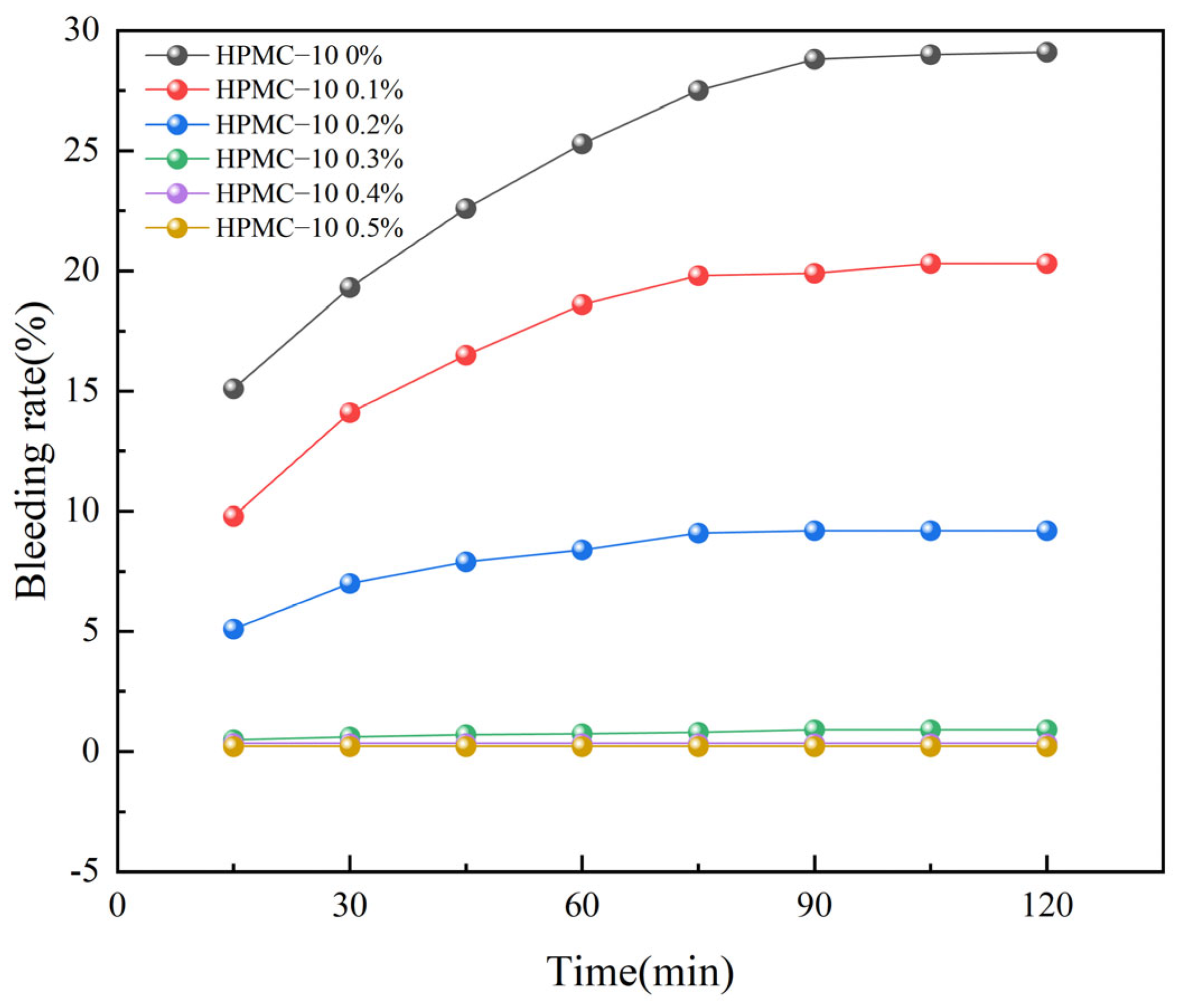

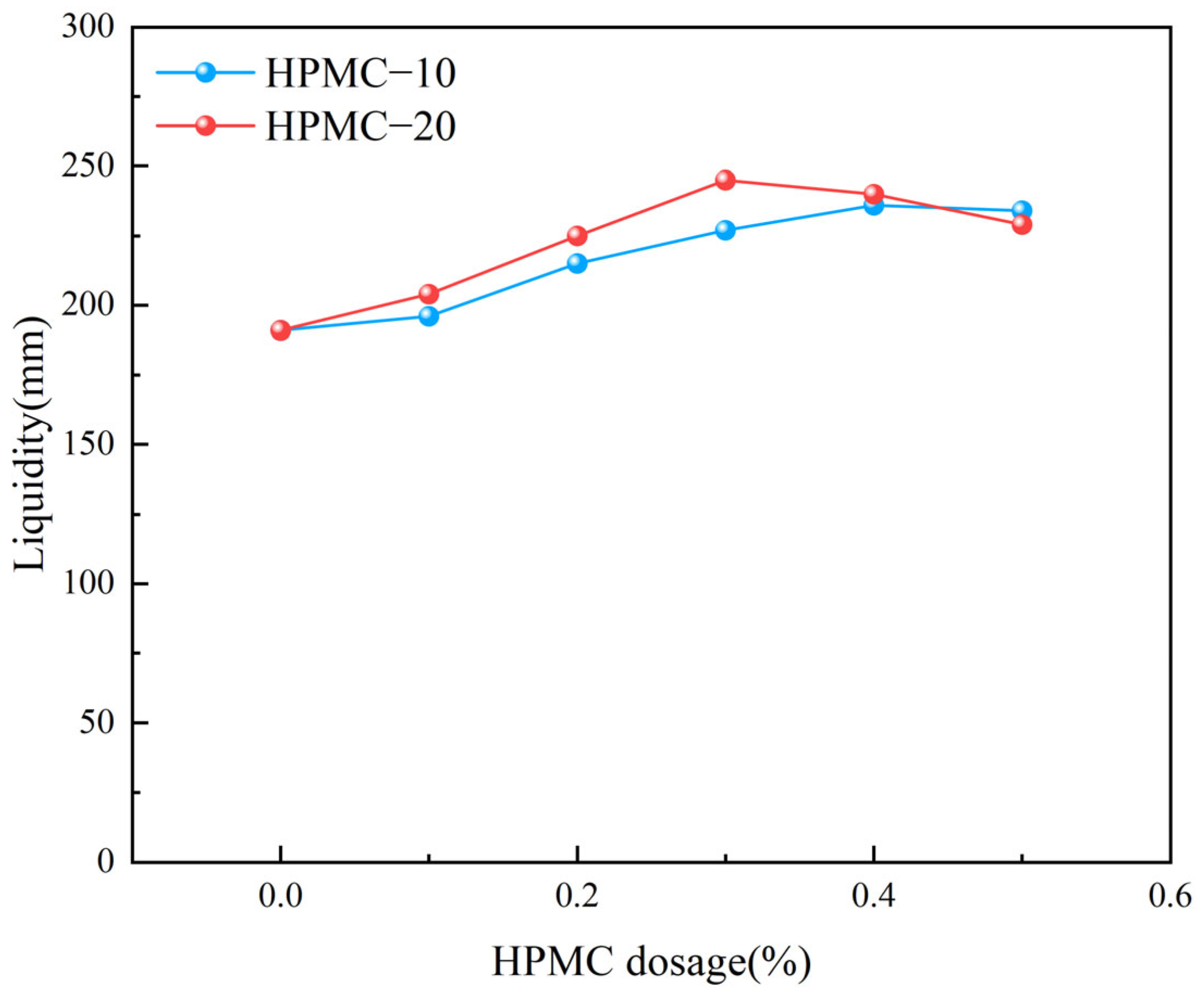
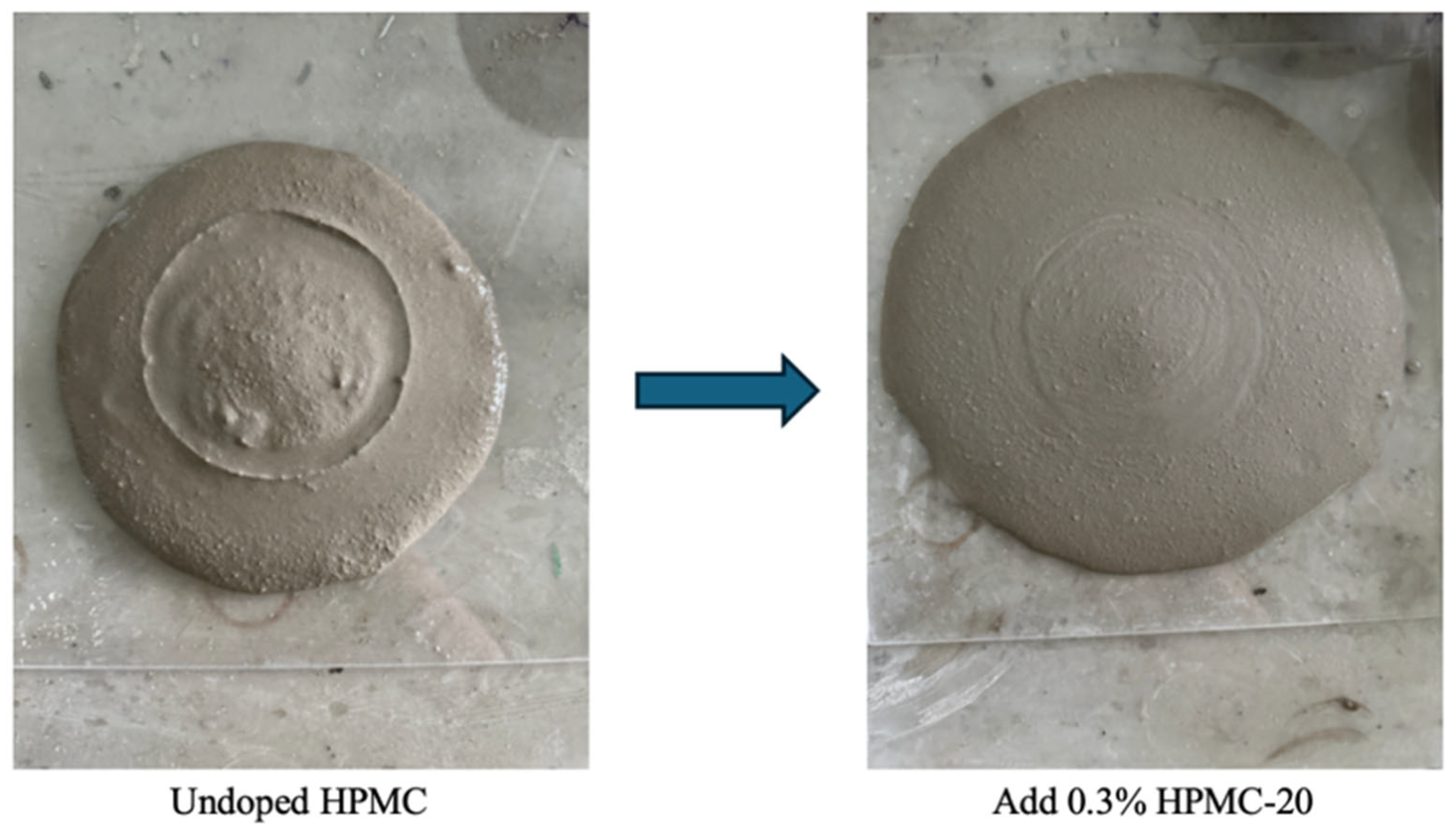
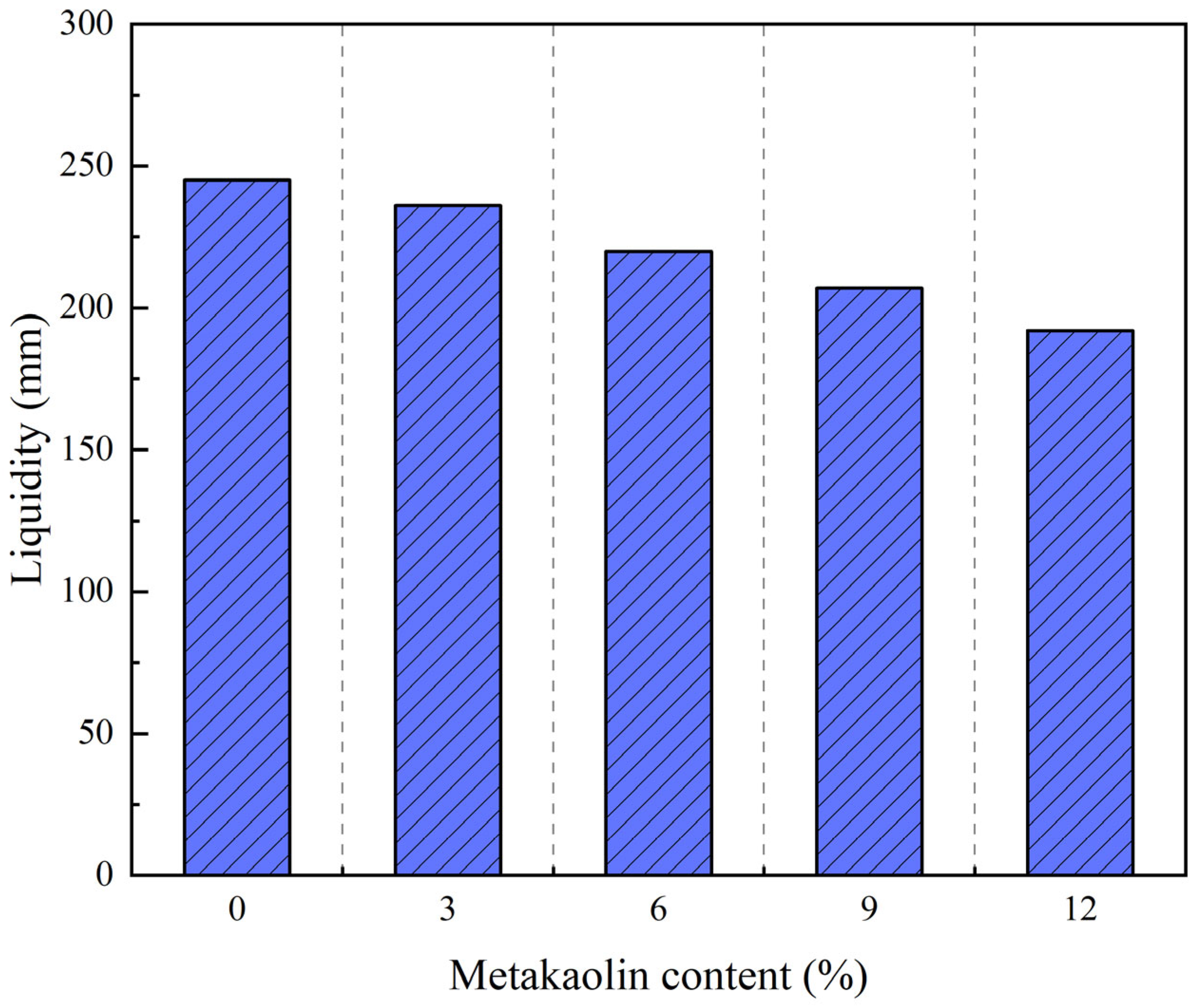



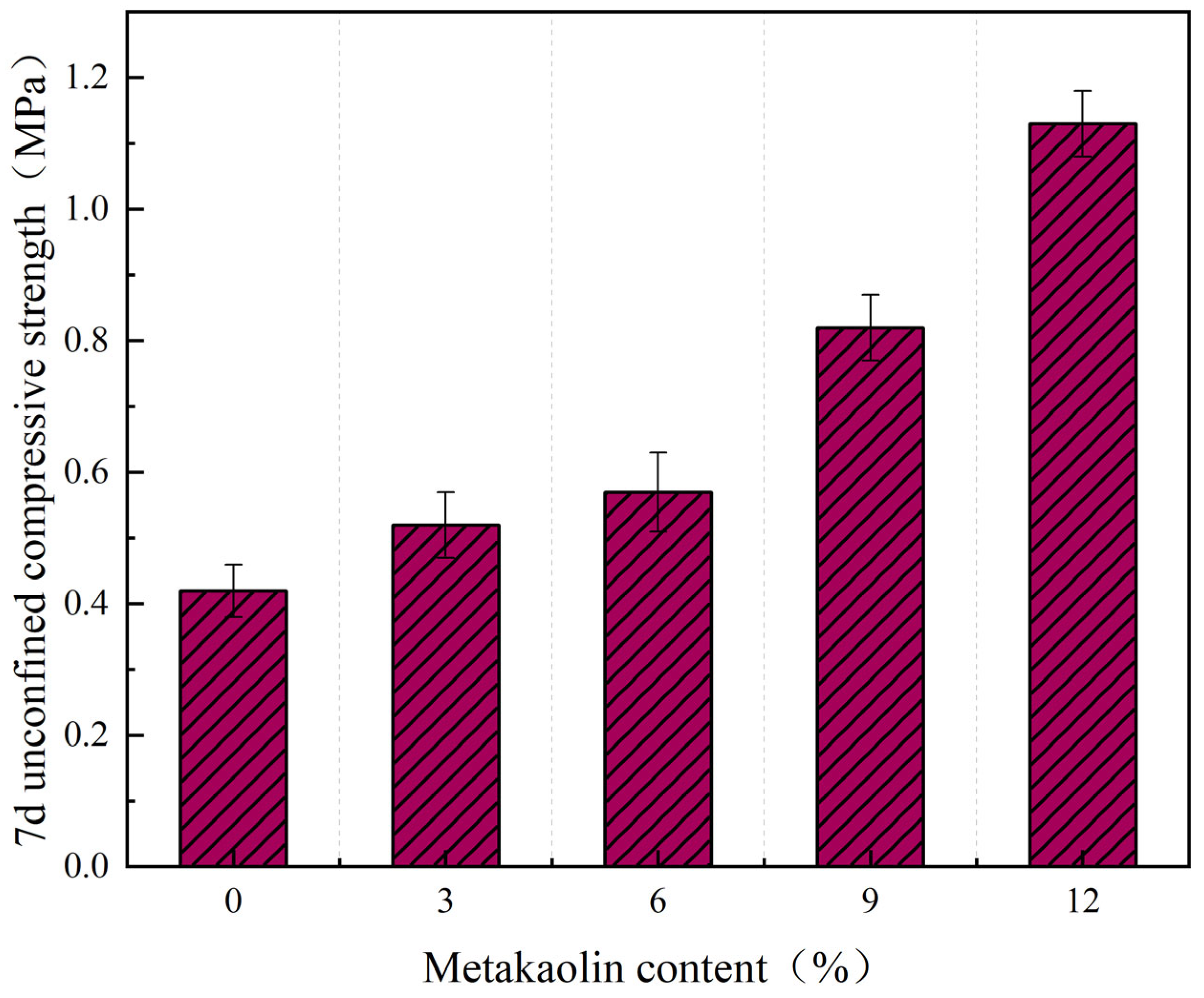


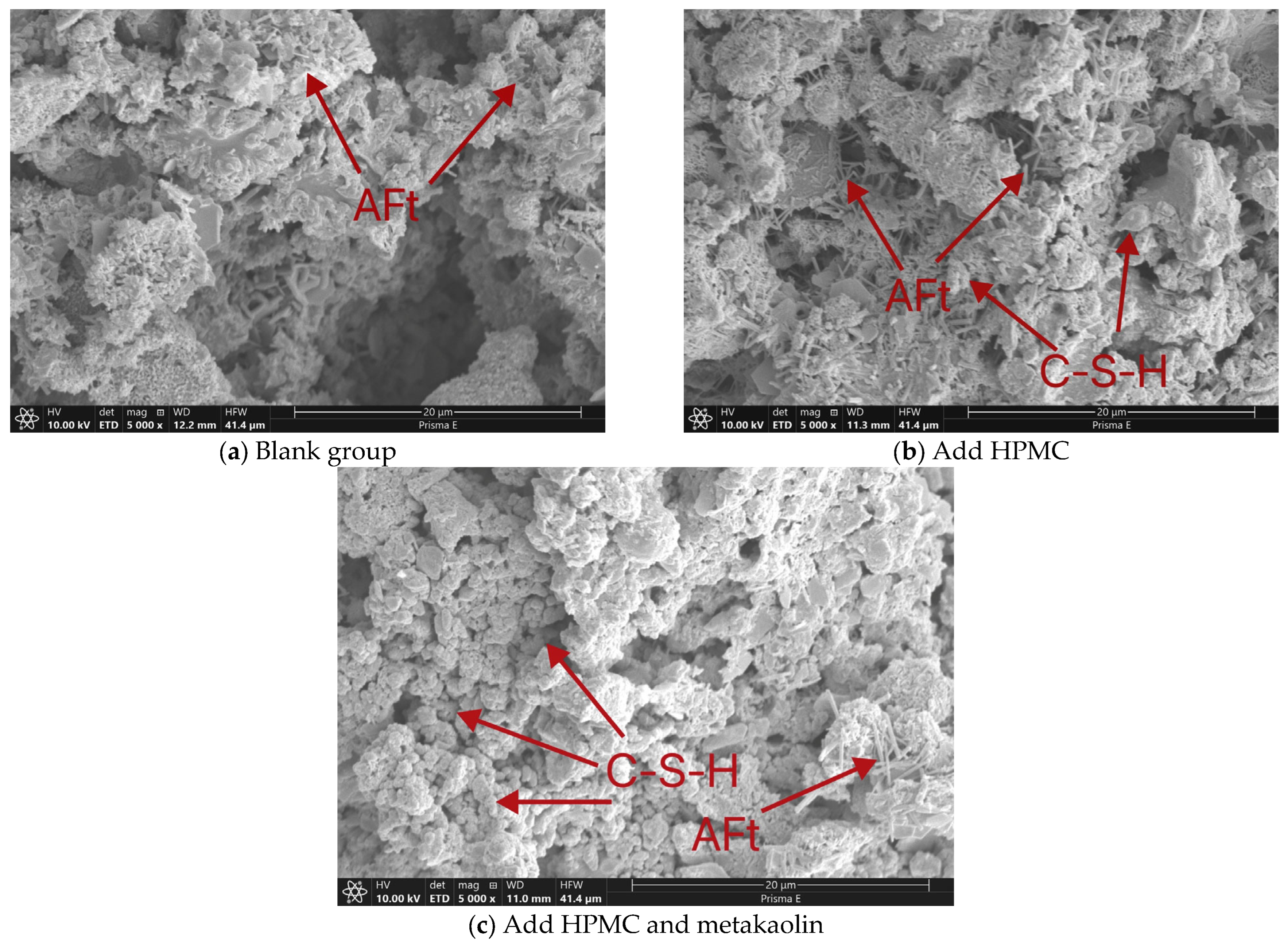
| Density/ (g·cm−3) | Fineness (80 μm)/% | Specific Surface Area/(m2·kg−1) | Compressive Strength/MPa | Flexural Strength/MPa | ||
|---|---|---|---|---|---|---|
| 3d | 28d | 3d | 28d | |||
| 3.11 | 2.6 | 375 | 23.8 | 48.9 | 5.5 | 9.2 |
| Component | CaO | MgO | CO2 | SO2 |
|---|---|---|---|---|
| content/% | 79 | 3 | 2 | 1 |
| Component | SiO2 | Al2O3 | Fe2O3 | TiO2 | K2O | MgO | CaO |
|---|---|---|---|---|---|---|---|
| content/% | 52.1 | 44.6 | 0.8 | 1.2 | 0.4 | 0.17 | 0.12 |
| Name | Average Molecular Weight | Viscosity/mPa·s | Ash Content | Methoxy Content | Hydroxypropyl Content |
|---|---|---|---|---|---|
| % | |||||
| HPMC | 100,000 | 105,100 | 5 | 22.2 | 10 |
| Name | Average Molecular Weight | Viscosity/mPa·s | Ash Content | Methoxy Content | Hydroxypropyl Content |
|---|---|---|---|---|---|
| % | |||||
| HPMC | 200,000 | 192,000 | 5 | 29.5 | 12 |
| Name | Cement | Quicklime | Metakaolin | HPMC |
|---|---|---|---|---|
| Add quantity/% | 16 | 15 | 3 | 0.1 |
| 6 | 0.2 | |||
| 9 | 0.3 | |||
| 12 | 0.4 | |||
| / | 0.5 |
Disclaimer/Publisher’s Note: The statements, opinions and data contained in all publications are solely those of the individual author(s) and contributor(s) and not of MDPI and/or the editor(s). MDPI and/or the editor(s) disclaim responsibility for any injury to people or property resulting from any ideas, methods, instructions or products referred to in the content. |
© 2024 by the authors. Licensee MDPI, Basel, Switzerland. This article is an open access article distributed under the terms and conditions of the Creative Commons Attribution (CC BY) license (https://creativecommons.org/licenses/by/4.0/).
Share and Cite
Tang, L.; Huang, K.; Shen, G.; Miao, Y.; Wu, J. The Effects of Hydroxypropyl Methyl Cellulose and Metakaolin on the Properties of Self-Compacting Solidified Soil Based on Abandoned Slurry. Materials 2024, 17, 2960. https://doi.org/10.3390/ma17122960
Tang L, Huang K, Shen G, Miao Y, Wu J. The Effects of Hydroxypropyl Methyl Cellulose and Metakaolin on the Properties of Self-Compacting Solidified Soil Based on Abandoned Slurry. Materials. 2024; 17(12):2960. https://doi.org/10.3390/ma17122960
Chicago/Turabian StyleTang, Liang, Kaijian Huang, Gong Shen, Yixin Miao, and Jiansheng Wu. 2024. "The Effects of Hydroxypropyl Methyl Cellulose and Metakaolin on the Properties of Self-Compacting Solidified Soil Based on Abandoned Slurry" Materials 17, no. 12: 2960. https://doi.org/10.3390/ma17122960
APA StyleTang, L., Huang, K., Shen, G., Miao, Y., & Wu, J. (2024). The Effects of Hydroxypropyl Methyl Cellulose and Metakaolin on the Properties of Self-Compacting Solidified Soil Based on Abandoned Slurry. Materials, 17(12), 2960. https://doi.org/10.3390/ma17122960






